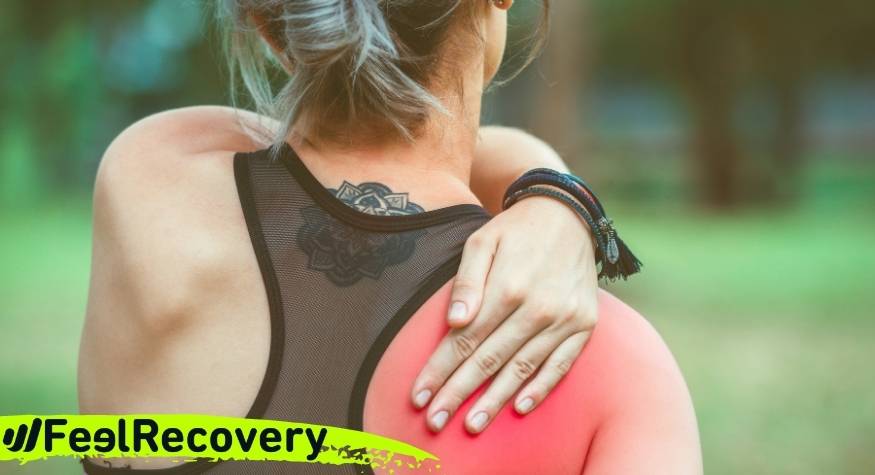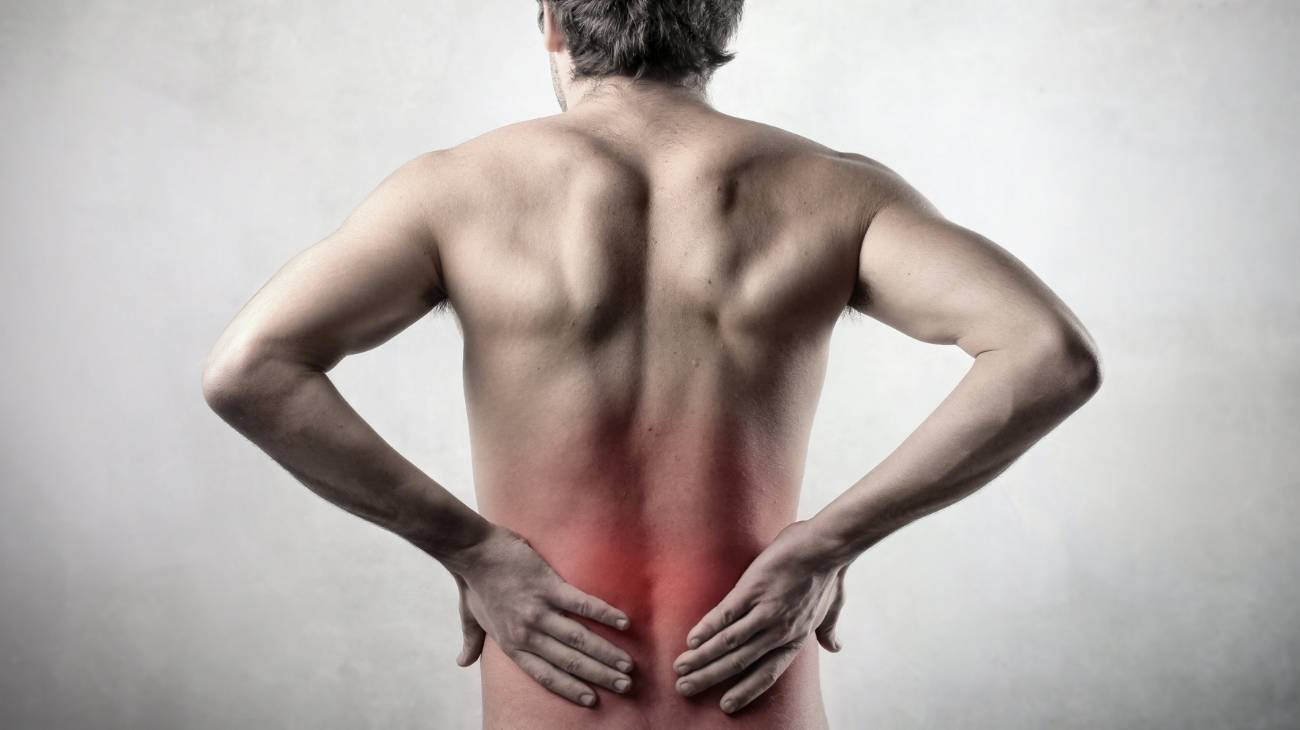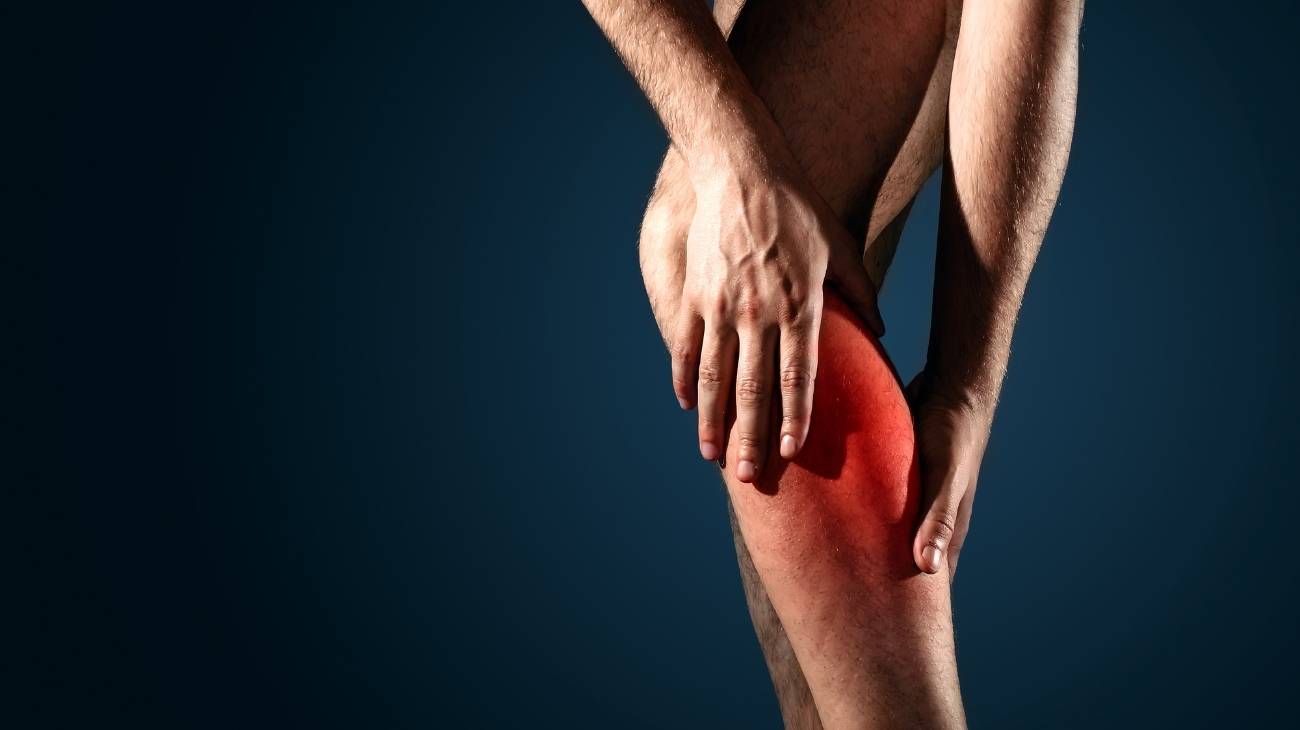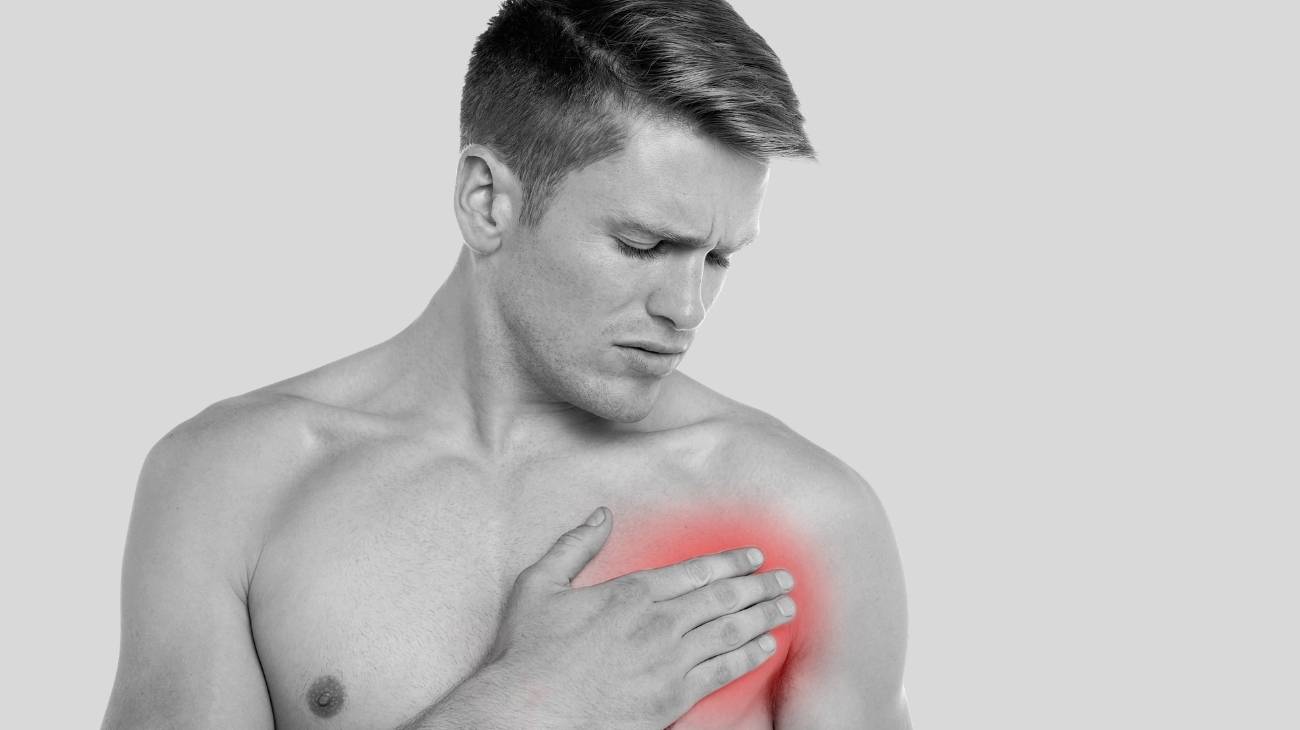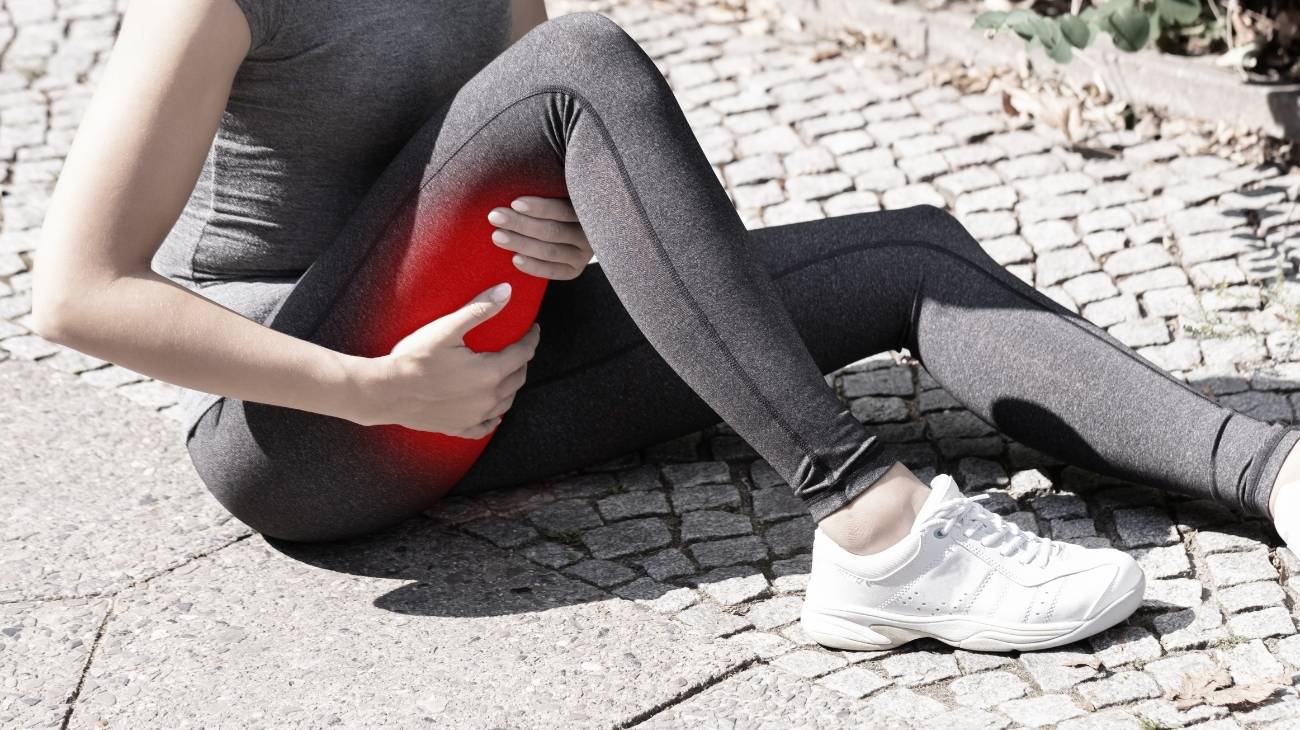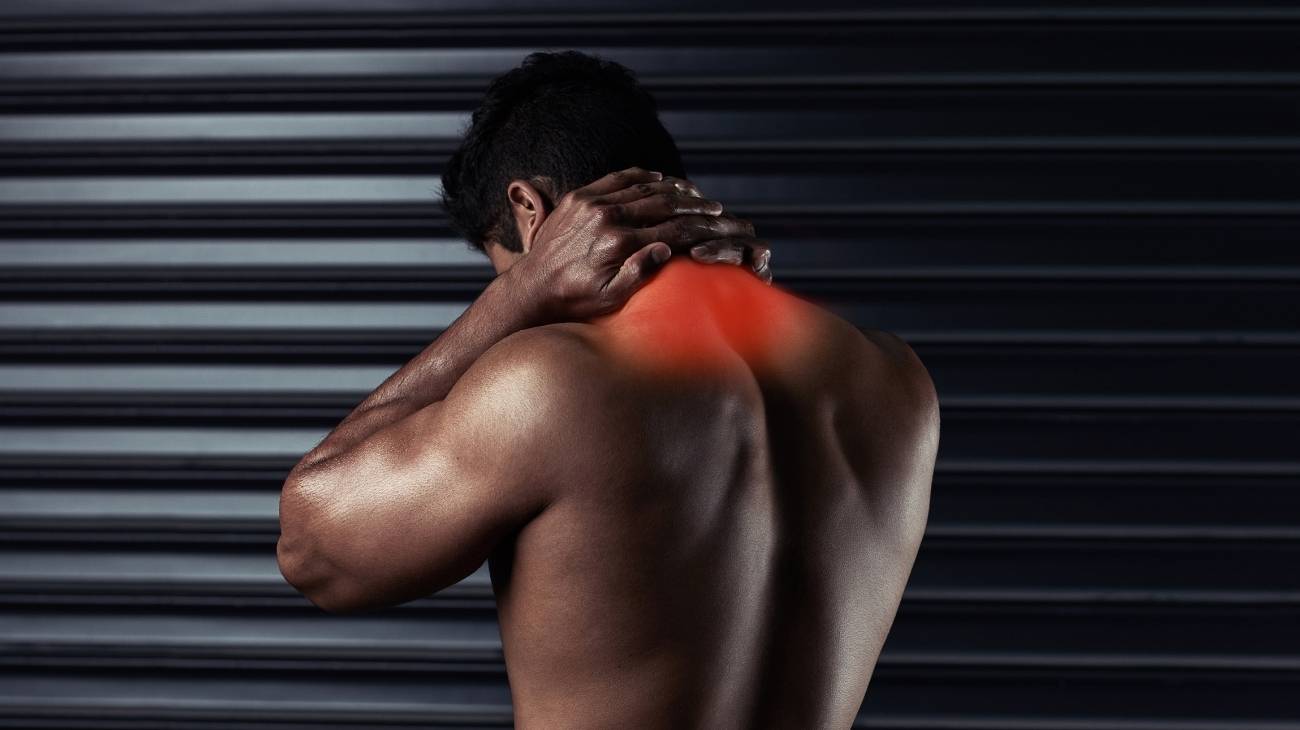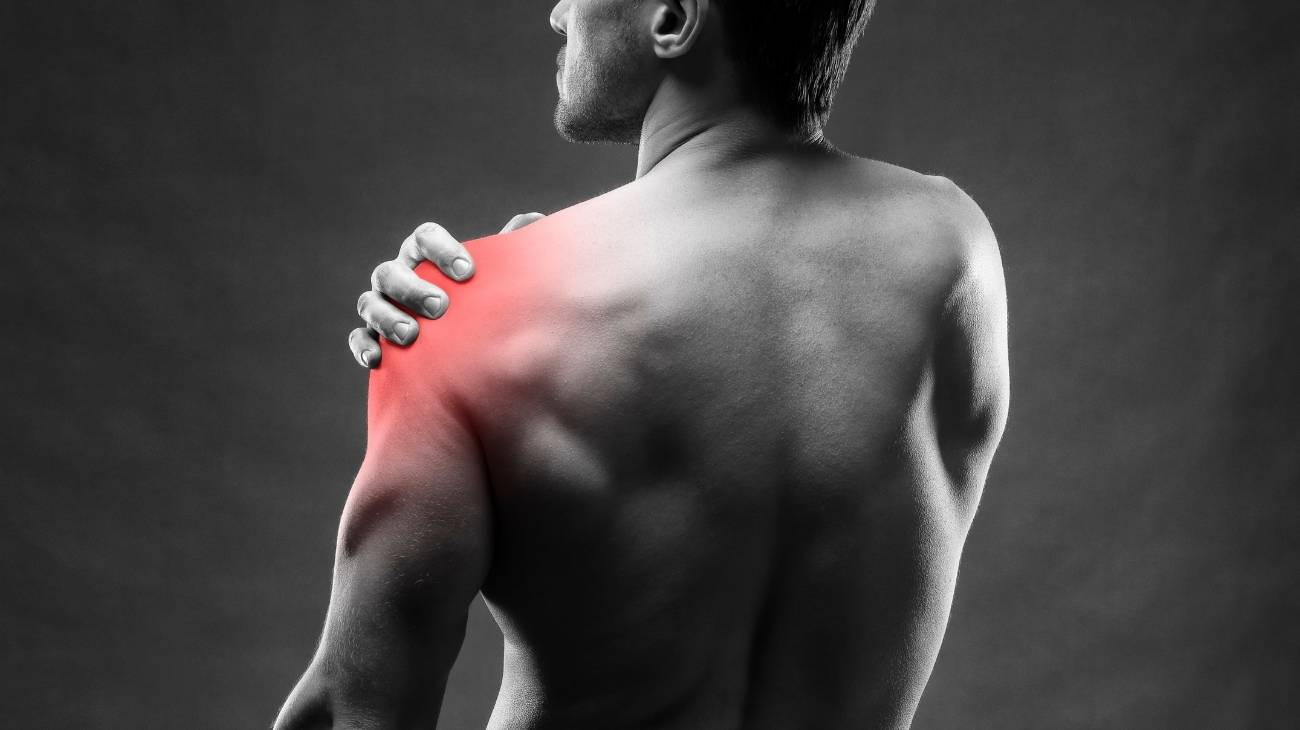- What are shoulder muscle strains?
- What are the causes of shoulder muscle strains?
- Best products for shoulder strains
- Main symptoms associated with shoulder and trapezius strains
- How to relieve the pain and improve the symptoms of shoulder muscle strains?
- What are the most effective methods of prevention for pulled muscles in the neck and shoulders?
We will explain in simple terms what shoulder and trapezius muscle strains are. This will help you to learn more about this ailment that affects many people, especially athletes and sedentary people.
That is to say, you will be able to read about the main signs of these muscular strains in the shoulder and the causes that originate it. Pay attention to every detail because you will learn about the treatments that help to reduce the pain and a list of the best tips that will help you to prevent muscle pull in the shoulder area.
What are shoulder muscle strains?
Shoulder strain is the involuntary tightening of the muscles in this part of the body due to the inability of the fibres to absorb waste from metabolic molecules. This causes the blood flow to fail to exchange gases and nutrients, resulting in pain and inflammation in the affected area.
This injury can be caused by a variety of factors, from dehydration to overexertion of the muscles. The duration of symptoms can vary from days to weeks, although in some cases it is likely to develop into a chronic strain, which must be treated with special therapies.
What are the causes of shoulder muscle strains?
See the following list in which you can read about all the circumstances and factors that increase the likelihood of a pulled shoulder muscle
- Low nutrient levels: Potassium, magnesium, sodium and calcium are all essential for proper muscle function. For this reason, a lack of any of these can cause neck and shoulder strains.
- Incorrect posture: Keeping the neck upright for too long or the shoulders in an unnatural position can lead to contractures in this area. In addition, it is common to lift heavy objects by forcing the trapezius muscles, thus causing involuntary tension in this structure.
- Previous traumas: Blows and any type of injury are the cause of muscular distensions and originate in this area. For this reason, it is advisable to visit the doctor urgently if you have suffered any type of accident that may affect this area.
- Inadequate rest: If you use too many pillows or, on the contrary, sleep without them, you can misalign the cervical spine with the head and maintain an uncomfortable position in the shoulders. This can be accompanied by low room temperatures, which will increase the likelihood of strain.
- Stress: High levels of stress involuntarily cause muscle stiffness in the body, especially in the shoulders and neck.
- Highly demanding activities: Lifting heavy objects all the time or straining your neck can cause injury to the shoulder and trapezius muscles. It is therefore advisable to stop this type of activity or to protect the area with compression garments.
- Sedentary lifestyle: lack of activity can cause the muscles to become accustomed to a different tension than normal. This can lead to sudden movements that can cause shoulder and neck injuries.
- Lack of stretching of the tissues: Both stretching and warming up beforehand are necessary activities to avoid the appearance of muscular ailments caused by the involuntary tension produced in the tissues. For this reason, it is advisable to perform pre-competitive movements before practising any sport or working with this area of the body.
- Advanced age: People over 60 years old are more prone to muscle injuries due to a lack of flexibility and strength.
- Excessive cold: It should not be forgotten that muscles are sensitive to temperatures, especially cold. For this reason, if a person catches cold, the muscular structure will tense up and can remain in this state involuntarily.
Best products for shoulder strains
Bestseller
-
Microwave Wheat Bag for Neck & Shoulder Pain Relief (Hearts)
£24,95 -
Microwave Wheat Bag for Neck & Shoulder Pain Relief (Oxford)
£24,95 -
Microwave Wheat Bag for Neck & Shoulder Pain Relief (Sport)
£24,95 -
Microwave Wheat Bag for Neck Pain Relief (Hearts)
£20,95 -
Microwave Wheat Bag for Neck Pain Relief (Oxford)
£20,95 -
Microwave Wheat Bag for Neck Pain Relief (Sport)
£20,95 -
Microwaveable Wheat Bag for Pain Relief (Hearts)
£20,95 -
Microwaveable Wheat Bag for Pain Relief (Oxford)
£20,95 -
Microwaveable Wheat Bag for Pain Relief (Sport)
£20,95
Main symptoms associated with shoulder and trapezius strains
Shoulder and trapezius strain can be noticed by signs that will appear on your body. Each of these symptoms will be presented below
- Pain: Muscle strains in the neck and shoulders cause general discomfort in the area. This is due to involuntary tension in the muscles located in this area.
- Dizziness: In slightly more severe cases of muscle pulls in this sector, it is possible to find patients suffering from migraine, dizziness and lightheadedness.
- Paraesthesia: Tingling sensations and loss of sensation in the area are common signs that appear in trapezius and shoulder strains.
- Inflammation: This type of symptom is caused by a lack of blood flow, which prevents the capillary walls from dilating properly. This leads to the accumulation of metabolic toxins in the tissues.
- Lack of mobility: This is another of the common signs that occur in people suffering from shoulder and neck strain. It should not be forgotten that this joint area is not only made up of muscles but also tendons and bursae that can affect the range of motion of the joint.
- Lumps: The appearance of nodules in the area are obvious signs of the involuntary tension that the muscles in that area are undergoing.
- Redness: In some cases it is possible to find the skin with a reddish colour in the neck and shoulder area. This may be caused by poor blood circulation in that area.
How to relieve the pain and improve the symptoms of shoulder muscle strains?
Nowadays, it is possible to reduce the symptoms of pulled muscles in the trapezius and shoulders by using different methods.
We will show you below the different treatments you can receive if you suffer from this type of injury:
Alternative and complementary therapies
Doctors can use different ancillary treatments to help reduce the pain and other symptoms of shoulder strain.
For this reason, we will show you which therapies are preferred by professionals:
- Cold and heat therapy: Although cold is not recommended for this type of treatment because the muscles react negatively. That is to say, the muscles tend to contract in response to the sensitivity of a low temperature. But the benefits of cold can be obtained by soaking with water or cold packs, although not at a freezing temperature. On the other hand, heat helps the patient to relax, thus increasing blood flow. This type of temperature is applied by means of hot water bottles or heat wraps. It should be noted that this therapy must be recommended and supervised by the doctor, as it cannot exceed 20 minutes.
- Compression therapy: It is possible to use collars to help immobilise the neck joint to rest the strained muscles. This must be supervised by a doctor, as the pressure exerted must be correct to stimulate the capillary walls and make the blood flow better.
- Massage therapy: Massage is one of the most commonly used therapies for this type of muscle injury. It is possible to use not only the hands to apply pressure, but also different elements that help to activate the blood flow so that it can eliminate the metabolites found in the region. It should be noted that massage therapy also reduces anxiety and stress, resulting in the overall well-being of the patient.
- Acupressure therapy: The objective is to find a mental balance and harmony in the patient, which will help the relaxation of the muscles located in the shoulder and trapezius. For this it is necessary to press different parts of the body to stimulate the central nervous system and cause a feeling of wellbeing.
- Thermotherapy: It should not be forgotten that the use of heat brings very acceptable benefits for this type of muscular injuries. This temperature can be applied by different methods, the most common being localised heat from a hot water bottle, heat wraps or electric blankets. However, electrotherapy or ultrasound can also be used to induce internal heat. This helps to decrease the information due to the stimulation of the bloodstream to circulate through the affected area of the body.
- Natural remedies using plants: Muscle injuries in the shoulder and neck can be treated by natural remedies using herbs. The method of use is the infusion, which contains anti-inflammatories, analgesics and muscle relaxants that are present in different plants. The most common of these are chamomile, peppermint, lime blossom and ginger.
- Healthy lifestyle habits: This treatment consists of re-educating the patient to improve living conditions and thus avoid new injuries or aggravation of the current contracture. This therapy includes habits related to diet, posture for various activities, daily exercises and muscle stretching.
Nutritional supplements
There are different nutrients that can be assimilated by the patient's body through food supplement powders, syrups and liquids. This helps to strengthen the muscular system not only of the shoulder and trapezius but also of the entire general structure. Included in this therapy are B vitamins, vitamins D and E, sodium, calcium, potassium and also magnesium.
Physiotherapy treatments
Physiotherapy aims to establish the adjacent muscular structures of the neck and shoulder. This improves the patient's sense of wellbeing and causes the pain to diminish and improves the movements of this part of the body. Different types of treatments can be used, but in general massages, movement exercises and the generation of heat through various techniques are applied in this area.
Medicines
Pharmacological therapies based on diclofenac and ibuprofen are used for the treatment of shoulder and trapezius strains. Opioid analgesics such as codeine, hydrocodone and oxycodone are also available. In some patients with seizure syndromes, lamotrigine is used as an anticonvulsant when they suffer lesions in this area.
These drugs should be prescribed by the attending physician, who will recommend the correct dosage and frequency. This means that self-medication is not advisable under any circumstances, as it can increase muscle injuries and cause other problems in the body.
What are the most effective methods of prevention for pulled muscles in the neck and shoulders?
It is possible to prevent neck and shoulder muscle pulls by means of simple methods. Therefore , we will show you below the actions and recommendations that you should take into account to avoid this ailment
- Do not perform activities that place excessive strain on the neck and shoulders: This will help you avoid straining the muscle structure due to sudden, jerky movements.
- Don't lift heavy things with this part of the body: The pressure that arises in the entire musculature when you lift items with heavy weights is very high, which can cause the muscles not to return to their normal tension after this action.
- Correct your posture: It is important to know the correct body positions when performing tasks or playing sports, especially when you spend a lot of time doing the same thing. In this way you will be able to help the whole muscle structure located in the neck and shoulders to have a comfortable position when working. This also applies to your sleeping position, so you should use pillows that are the right height to level your head and cervical spine.
- Physical activity: Exercise will help you avoid a sedentary lifestyle by getting the bloodstream flowing properly through this area of the body. Remember that progress and effort must be gradual to avoid the appearance of lactic acid, which can cause muscle strain.
- Reduce stress: Worries and situations that make you feel nervous or frustrated generate involuntary muscle tension. This can lead directly to shoulder strains, but you can increase the likelihood every time you perform a bad force or receive a blow to the shoulder.
- Warm up and stretch your trapezius and shoulders: Before doing any activity, it is advisable to warm up the muscles beforehand so that they gradually receive the effort. In addition, when the task is finished, it is necessary to stretch the muscles of the neck and shoulder to restore the correct tension of the tissue.
- Eat healthy: A balanced diet rich in vitamins and minerals will help to keep the muscle fibres in good condition. This will make muscle strains less likely to occur. Don't forget that hydration is essential to keep your muscles in good working order.
- Choose the benefits of heat: Thermotherapy will help you to make the affected area more flexible, so it is advisable to place hot water bottles or electric blankets on the neck and shoulder. In this way, the bloodstream will be stimulated and residual toxic substances in the muscles will be prevented.
- Choose relaxation methods: You can choose meditation as a technique to loosen the muscles, but this is not the only one, as it all depends on what relaxes you. For example, you can choose to read a book, walk or cook.
- See a doctor at the slightest symptom: It is important to see a doctor if you feel discomfort in the neck or shoulder area. This will prevent the strain from lasting for a long time and also prevent a relapse during treatment.
References
- Herberts, P., Kadefors, R., Högfors, C., & Sigholm, G. (1984). Shoulder pain and heavy manual labor. Clinical Orthopaedics and Related Research (1976-2007), 191, 166-178. https://journals.lww.com/corr/Abstract/1984/12000/Shoulder_Pain_and_Heavy_Manual_Labor.22.aspx
- Erdelyil, A., Sihvonen, T., Helin, P., & Hänninen, O. (1988). Shoulder strain in keyboard workers and its alleviation by arm supports. International archives of occupational and environmental health, 60, 119-124. https://link.springer.com/article/10.1007/BF00381492
- Jonsson, B. (1982). Measurement and evaluation of local muscular strain in the shoulder during constrained work. Journal of human ergology, 11(1), 73-88. https://www.jstage.jst.go.jp/article/jhe1972/11/1/11_1_73/_article/-char/ja/
- Brox, J. I. (2003). Shoulder pain. Best Practice & Research Clinical Rheumatology, 17(1), 33-56. https://www.sciencedirect.com/science/article/abs/pii/S1521694202001018
- Hidalgo-Lozano, A., Fernández-de-las-Peñas, C., Alonso-Blanco, C., Ge, H. Y., Arendt-Nielsen, L., & Arroyo-Morales, M. (2010). Muscle trigger points and pressure pain hyperalgesia in the shoulder muscles in patients with unilateral shoulder impingement: a blinded, controlled study. Experimental brain research, 202, 915-925. https://link.springer.com/article/10.1007/s00221-010-2196-4
- Orchard, J., & Best, T. M. (2002). The management of muscle strain injuries: an early return versus the risk of recurrence. Clinical Journal of Sport Medicine, 12(1), 3-5. https://journals.lww.com/cjsportsmed/fulltext/2002/01000/the_management_of_muscle_strain_injuries__an_early.4.aspx
- Noonan, T. J., & Garrett Jr, W. E. (1999). Muscle strain injury: diagnosis and treatment. JAAOS-Journal of the American Academy of Orthopaedic Surgeons, 7(4), 262-269. https://journals.lww.com/jaaos/Abstract/1999/07000/Muscle_Strain_Injury__Diagnosis_and_Treatment.6.aspx
- Beiner, J. M., & Jokl, P. (2001). Muscle contusion injuries: current treatment options. JAAOS-Journal of the American Academy of Orthopaedic Surgeons, 9(4), 227-237. https://journals.lww.com/jaaos/Abstract/2001/07000/Muscle_Contusion_Injuries__Current_Treatment.2.aspx
- Orchard, J. W., Best, T. M., Mueller-Wohlfahrt, H. W., Hunter, G., Hamilton, B. H., Webborn, N., … & Glasgow, P. (2008). The early management of muscle strains in the elite athlete: best practice in a world with a limited evidence basis. British Journal of Sports Medicine, 42(3), 158-159. https://bjsm.bmj.com/content/42/3/158.short
- Butterfield, T. A. (2010). Eccentric exercise in vivo: strain-induced muscle damage and adaptation in a stable system. Exercise and sport sciences reviews, 38(2), 51-60. https://journals.lww.com/acsm-essr/Fulltext/2010/04000/Stretch_Activated_Ion_Channel_Blockade_Attenuates.00003.aspx





































